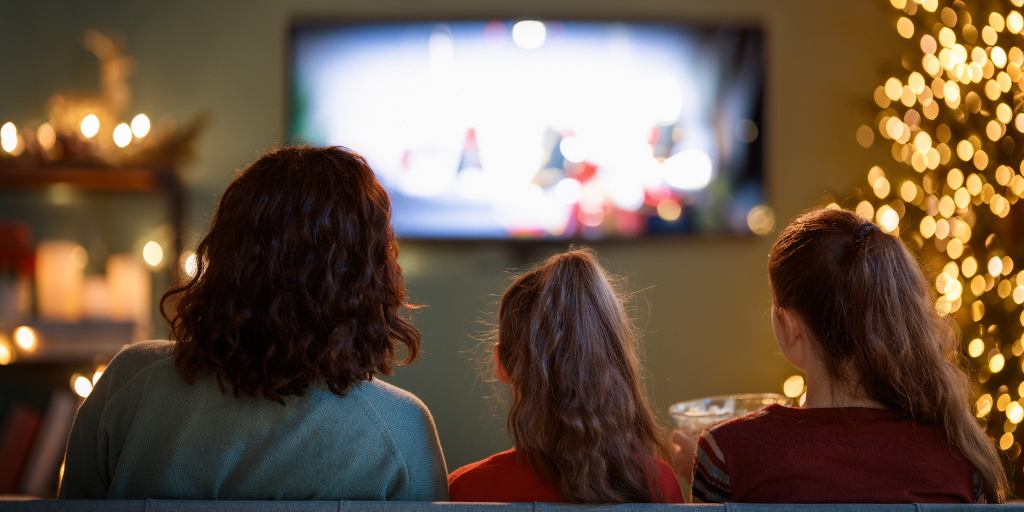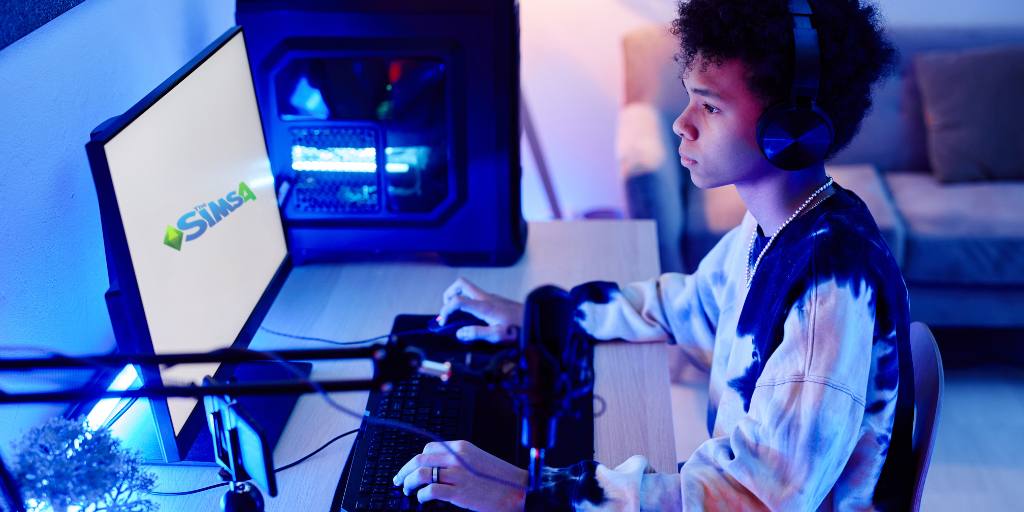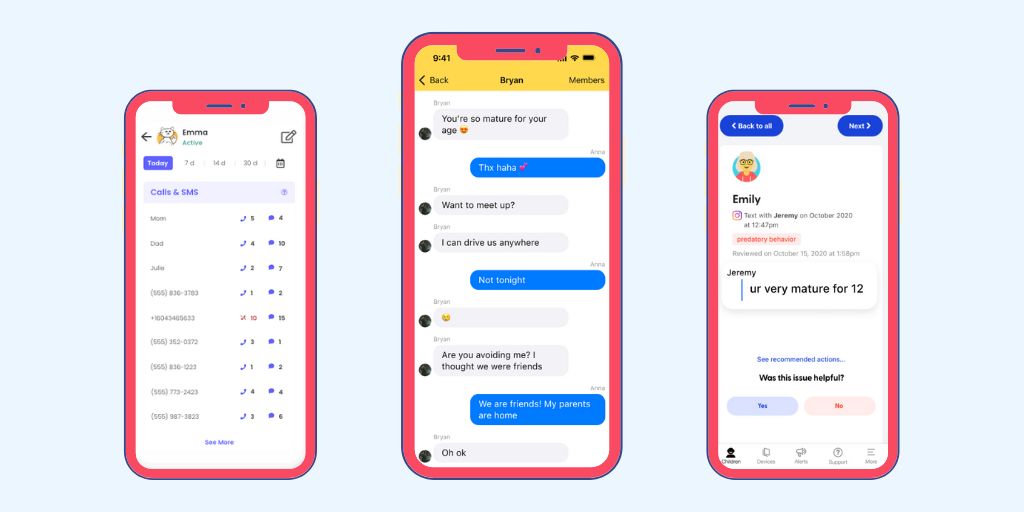
Talking to your child about how to stay safe online is super important. But it can be hard to know what to say. For help getting started, check out these essential online safety tips for kids to help protect them from cyber threats, scams, and online predators.
One of the best things you can do to keep your kids safe online is to make sure their social media accounts are all set to private. This minimizes the chances that personal information about them will fall into the wrong hands. It also decreases (but doesn’t totally eliminate) opportunities for strangers to contact them.
Pro tip: Regularly review privacy settings. Social media platforms frequently update their policies.
Children often share more than they realize on social media, including:
Teach your child to think before they post and avoid sharing anything that could compromise their safety.
Online predators often pose as friendly strangers. Teach your child:
While it’s generally not a good idea for kids to connect with people they don’t know online, there are some exceptions.
For example, maybe they’ve really clicked in the comments with a friend of a friend, and you’ve been able to vet them through mutual contacts. Or perhaps they have a marginalized identity but struggle to find a local community to connect with, so you’ve okayed something like TrevorSpace — and they hit it off with someone local.
If your child does make a friend online who they want to meet in-person, make sure they:
Encourage open conversations about online friendships and potential risks. Learn more about how to help your child make strong offline friendships.
Help your child come up with a plan for what to do if someone makes them uncomfortable online, such as:
Emphasize to your child the importance of thinking critically about what they come across online. Teach them digital literacy skills, such as:
Encouraging digital literacy helps kids avoid scams, manipulation, and misleading information.
The marketing of illegal substances on social media has increased in recent years. In fact, around 60% of teens have seen drug content on social media, and 10% report having purchased drugs through these platforms.
Talk to your child about the risks of drugs and why it’s important to never purchase substances online. Depending on their age and maturity level, you may also want to discuss how dealers use code words and emojis to target kids and why online substances are often laced with harmful ingredients.
Scammers don’t spare the youth. In fact, some online schemes specifically target children and teens. Warn your child against clicking on any links sent to them unless they are from a trusted source.
For example, scammers may target kids with phishing links disguised as:
Teach your child: “If you’re unsure, don’t click!”
With so much misinformation out there, teach your child to be part of the solution by checking their sources before they share something online.
Reposting a juicy bit of gossip can also go sideways real quick. Encourage them to take a beat before hitting share and ask themselves if it’s something they would want posted about them.
Parents play a vital role in teaching their kids how to stay safe online. By teaching smart digital habits, setting strong privacy settings, and using parental monitoring tools like BrightCanary, you can help protect your child from online dangers. Want detailed insights into your child’s online activity? BrightCanary helps parents monitor for potential risks on texts, social media, Google, and YouTube. Download the app and get started for free today.

Finding the perfect book for a 14-year-old girl can be challenging. Whether she loves historical fiction, fantasy, thrillers, or stories about self-discovery, this parent guide highlights must-read books that will entertain, inspire, and educate. Ready to help your teen find their perfect next read?
This list isn’t exhaustive, and it’s based on our own editorial perspective as parents of tweens and teens.

Genre: Thriller, survival fiction
Plot: Three sisters raised on the secret compound of a doomsday prepper community train to hunt, homestead, and protect their own. When danger from within puts them in danger, the girls must put their training into action as they realize nowhere is safe.
Why it made our list: This page-turning thriller is a fascinating window into prepper culture. It features strong teenage characters and leans into the importance of sisterhood. Teens will relate to themes of seeking independence, figuring out one’s place in the world, and finding hope in difficult circumstances.

Genre: Contemporary romance
Plot: When Lily ditches her ADHD meds and lands in detention with Abelard, who’s Autistic, she’s intrigued. The teens fall for each other over a shared interest in ancient love letters, but struggle to bridge their differences off the written page.
Why it made our list: Neurodiversity is accurately and respectfully portrayed in this hilarious, sweet, and, at times, heartbreaking love story. The addition of the letters adds an interesting texture to the book.

Genre: Young Adult
Plot: Liz has always believed she's too black, too poor, too awkward to shine in her small, rich, prom-obsessed midwestern town. As part of her plan to escape Campbell, Indiana, forever, Liz finds herself an unlikely contender for prom queen in the hopes of earning a scholarship. Everything changes when she falls for the competition.
Why it made our list: Watching Liz and Mack fall for each other in the middle of a small town is the kind of heartwarming portrayal of queer Black joy we want more of in literature. There's gobs of cuteness as the girls discover their feelings for each other and the realistic way Liz’s other friendships are portrayed jump off the page.

Genre: Historical fiction, supernatural
Plot: As infants, twin sisters Charlie and Magnolia were secretly separated after their parents were brutally lynched for loving across the color line. They reunite as teenagers at the dawn of the Civil Rights Movement. Charlie is a young Black organizer in Harlem, and white-passing Magnolia is the heiress to a cotton plantation in rural Georgia.
Why it made our list: Mirror Girls masterfully blends historical fiction, horror, and the supernatural to great effect. It’s a powerful examination of race, social justice, and privilege that will resonate for today’s teens.

Genre: Fantasy, mystery
Plot: When 17-year-old Alice’s grandmother, the reclusive author of a book of pitch-dark fairy tales, dies alone on her estate, things go from bad to worse. After her mother is stolen away by a figure from one of her grandmother’s stories, Alice is forced to venture into the strange and treacherous world where her grandmother's tales began.
Why it made our list: The world Albert creates in this book is rich and absorbing. Alice’s close relationship with her mother is authentic and believable. It’s the rare YA fantasy book these days without a major romance subplot, so if your teen isn’t into the steam, this is a refreshing break.

Genre: Graphic novel, contemporary fiction
Plot: Issaac is an Arab-American college student struggling to live with epilepsy. The doctors won’t listen, his family is in denial, and his social life falls apart as he feels increasingly isolated by his illness.
Why it made our list: Mis(h)adra is a graphic novel with vibrant, manga-style illustrations that create a visual depiction of living with a disability, based in part on the author’s own disabled experience. Universal themes of overcoming self-doubt and struggling to fit in will resonate with disabled and able-bodied readers alike.

Genre: Nonfiction, history
Plot: Flowers in the Gutter tells the captivating true story of a group of German teenagers — known as the Edelweiss Pirates — who resisted the Nazis using whatever means possible.
Why it made our list: In a time when the world feels so uncertain and perilous, it’s easy for teens to feel like they have no capacity to make change. This book provides a powerful example of youth activism in a raw, unvarnished way. Because of its narrative nonfiction style, it reads like a novel, making it appealing to teens who aren’t traditionally nonfiction readers.

Genre: Self-help, nonfiction
About: Huber used surveys and interviews with hundreds of teenagers to discover what does and doesn’t work in their lives, how they perceive the adult world they’re about to enter, and what they want adults to know about them. The result is a self-help book with communication techniques to empower teens to take the lead in the often tricky, but necessary conversations between teens and adults.
Why it made our list: Advice for teens often comes solely from the perspective of the adults giving it. We love that the author talked to teens about their lived experiences and crafted her suggestions based on what they actually need and want.
These titles offer a mix of fiction and nonfiction, showcasing stories that address identity, resilience, activism, and relationships. Whether your teen is looking for an escape into a fantastical world or seeking guidance on real-life struggles, books can provide engaging, empowering, and relatable narratives.
Encouraging a love of reading in teens is about more than entertainment — it’s about offering them stories and guidance that resonate.
Looking for more ways to support your teen’s habits? BrightCanary helps parents stay informed about their child’s digital world while promoting healthy media consumption. Get started for free today!

Monitoring your child’s text messages is a responsible step toward their online safety, but how you approach it matters. Without thoughtful monitoring, you risk breaking trust, overlooking key issues, or overstepping boundaries. Here are the top mistakes parents make when monitoring their child’s texts — and how to avoid them.
Going behind your child’s back to monitor their messages is almost guaranteed to backfire when they inevitably find out. Trust is a two-way street. Once it’s broken, they may try harder to hide their online activity.
Instead, be open with your child about your monitoring and explain that it’s for their safety, not to invade their privacy. They’ll be more likely to return the effort by being honest with you about their behavior.
If you view monitoring your child’s texts as a way to catch them misbehaving, they’ll see you as an adversary instead of a trusted guide. They’re likely to resent your actions and may go out of their way to evade your monitoring efforts.
Instead, approach monitoring as a partnership. You should have a mutual goal of keeping them safe and helping them if they make a mistake.
When monitoring kids, parents need to decide what constitutes “red flag” behavior and what is merely notable-but-harmless behavior.
I just learned the term “beige flag,” and I kind of love it. It’s a dating culture term meaning behavior that may be odd or strange, but that doesn’t rise to the level of concern. I think “beige flags” can also apply to parenting.
If your child uses some swear words in casual conversations but isn’t engaging in risky behavior, it’s likely not worth calling out. Are they actively texting about drugs and alcohol? Red flag — time to step in.
If your kid doesn’t know what’s expected of them, how can they follow the rules? They may feel blindsided when you call them out for something they didn’t realize was a problem.
Be clear about how you expect them to behave when texting and put it in writing with a digital device contract. This helps kids understand what’s appropriate and reduces conflict later on.
Monitoring your child’s texts is not a substitute for open communication. Even the best parental controls can’t catch everything. Talk to your child regularly about online risks and help teach them how to be a responsible texter.
➡️ BrightCanary makes monitoring easier by flagging potential risks in your child’s texts. That way, you can focus on having meaningful conversations instead of reading every message.
As difficult as it may be, you need to respect the fact that your child deserves to keep some things private. The same goes for not deliberately digging around on their phone to find out the gossip about their life. Focus your monitoring on safety issues. The rest is only your business if your child wants it to be.
Suppose that you learn your child has a new significant other, but they haven’t shared the news with you yet. You’ll probably want to run and ask them about the person — and why they didn’t tell you. DON’T do it.
It’s so tempting to read every message! It’s right there — why not? Well, for one thing, trying to read every single one is unnecessary and overwhelming. The average teen receives at least 237 texts per day, according to Common Sense Media.
Reading every single text may also contribute to your child feeling like you’re spying on them. As your child grows older and more mature, you’ll want to loosen the reins, and reading everything only adds to your mental load.
A monitoring app like BrightCanary gives you your time back. You can simply browse the “concerning” tab to view alerts about anything potentially inappropriate.
If you find something concerning, the first step is to (calmly) ask your child about it. Find out the full story from them, assuming the best until you find out otherwise. Ask open-ended questions like:
Approaching with curiosity instead of immediate punishment encourages honesty and growth. Remind them that your job is to keep them safe, and you want to work through this together.
You can’t protect your child from everything. Nor should you try. There’s value in making mistakes, especially when your child is still young and has you to help support them through the aftermath. Address the big stuff that you find on their texts, but also look for places where you can give them room to fail. That’s where the growth will happen.
Monitoring your child’s texts can protect them from digital risks, but it’s crucial to do it thoughtfully. Avoid these mistakes by being transparent, focusing on safety over control, and using tools like BrightCanary to support healthy digital habits.
Want to monitor your child's texts on iPhone? Try BrightCanary and get started for free today!

Watching movies with your teen is a great way to bond, introduce them to important themes, and even spark valuable conversations. If you’re lucky enough to have a teen still willing to do family movie night (or if you’ve given them no choice), here are some films to add to your list.
Wicked is the part one of the adaptation of the hit Broadway musical. It tells the backstories of characters from The Wizard of Oz, centering around roommates Elphaba (Wicked Witch of the West) and Galinda (Glinda the Good Witch).
This untraditional coming-of-age movie follows Mason as he matures from age 7 to 19. Most notably, it was filmed over the course of 12 years so the actors could be shown aging naturally through the story.
A cult-classic fairytale adventure about a young woman and her one true love.
This touching love story about two teens with cancer is based on the book by the same name.
This sci-fi adventure tells the story of a hacker who is led to the underworld, only to discover the true nature of his reality and his role in the war against the evil cyber-intelligence overlords.
This movie, based on an award-winning book, tells the story of a Black teen girl who witnesses the fatal police shooting of a close friend. This movie is likely to lead to some pretty big, but vital conversations with your teen.
Based on the bestselling book, this fantasy film tells the story of a teenager who discovers a secret school for children with special powers.
In this rom-com based on a novel by the same name, teenage Jenny Han’s little sister mails Jenny’s secret love letters to all her former crushes.
Based on the best-selling book series, The Hunger Games takes place in a dystopian world where two teenagers from each of the twelve Districts are chosen at random to fight to the death in a yearly televised competition.
A group of LGBTQ+ high school students form an after-school club as a discreet way to share their experiences and support one another.
From pure entertainment to a stepping stone for deeper discussions, these movies are a great choice to watch with your teen. Which one are you adding first to your next family movie night?
Heads up: BrightCanary can help you stay informed about your child’s interests and what they’re watching, searching, and sending online, including YouTube and text messages. Download the app and start monitoring for free today.

A strong relationship with your child is essential for their emotional well-being, confidence, and overall development. But in today’s digital age, nurturing your connection with your tween or teen can feel especially challenging. The good news is that small, intentional actions can make a big difference.
Research shows that strong parent-child relationships are associated with a wide range of positive social, emotional, health, and cognitive outcomes for children.
Although peer relationships become more important during adolescence, a strong parent-child relationship is still important. It makes kids feel safe as they face the challenges of adolescence and helps give them the confidence they need to explore and try new things.
As if parenting weren’t hard enough, modern technology adds to the challenge. Here are some reasons why technology may make connecting with your child difficult:
As kids grow older, it’s normal for parents to end up on the backburner as peer relationships become more important. But parental influence still matters. It simply requires a shift in how you connect with your child.
Teens are literally hardwired to tune out their parents’ voices and tune in to other voices. It’s developmentally normal for them to pull away from their parents and seek increased autonomy.
Basically, you’re fighting against biology if you expect your relationship with your teen to look like it did a few years ago.
Instead, seek smaller ways to connect with them, like catching up on their day on the ride home from school or taking them out for a treat one-on-one. Try not to get hurt if they reject your efforts. And whatever you do, don’t stop trying.
Teens can smell the pressure to open up a mile away, so it’s often more effective to do things together that you both enjoy, such as cooking, watching movies, or hiking. If you and your child don’t share any common interests, ask them to share what they enjoy with you.
Remember: You may be dying to have a heart-to-heart, but that isn’t required in order to have a healthy, trusting relationship with your child. The key is to be willing to step outside your comfort zone and really give the activity a shot.
Car rides are an often underestimated source of connection with teens. Not only do you have a captive audience, but car talks also remove the pressure of direct eye contact, which can make discussions easier.
Try asking open-ended questions while on the road. Resist the urge to lecture or scold them. Be patient and receptive, and let them lead the conversation.
Phone use can inhibit connection, in part because we smile less when we’re absorbed in a screen. When you do get precious time with your child, try setting your phone aside and asking them to do the same.
It’s also helpful to have designated screen-free times in your house, such as during meals. You might even consider doing a family digital detox.
Didn’t I just tell you to turn off tech? Yes, but technology can also be used to your advantage when it comes to connecting with your child. The key is to be intentional about it.
Texting your teen isn’t just for logistics, like asking them to do chores or confirming what time they need a ride. Check in with them, send them funny memes, or just let them know you’re thinking of them.
They might roll their eyes at your dad jokes or get embarrassed from your heart emojis, but deep down, they’ll be glad to know you’re thinking of them.
(You might want to check out these tips for texting teens first, though.)
Stay connected with your teen’s online life. BrightCanary monitors texts, Google, YouTube, and social media for concerning content, including explicit images and drug references. Get started for free today.
It’s easy to want to jump into problem-solving mode when our kids confide in us. If you’re lucky enough to have a teen who comes to you when they need an ear, listen before you try to offer solutions or opinions. Practice active listening, focusing any questions on helping them gain their own clarity on the issue.
Navigating parent-child relationships in the digital age can be challenging, but intentional connection efforts make a difference. How to connect with your child isn’t about grand gestures — it’s about consistency, patience, and adaptability. If parents shift their approach, they can still find ways to have a strong relationship with their children. The effort is always worth it.

Screens are an inextricable part of modern life for teens, but excessive device use can lead to negative impacts like behavioral issues and problems sleeping. The Surgeon General has even issued guidance on limiting screen time, particularly for social media. A digital detox is a great way to reset screen use and help teens form better long-term habits.
A digital detox is a set period where a person reduces or completely avoids digital devices such as smartphones, computers, and social media.
Whether your teen takes part in a full cleanse or just a careful reduction of their device use, there are many benefits to a digital detox.
For many teens, social media is a significant contributor to stress and anxiety. Chronic stress takes a toll on both the mind and the body.
Taking an intentional pause from online spaces gives kids a chance to rest and rejuvenate.
Excessive device use is linked to increased sleep disturbances.
A digital detox can temporarily improve the quality of your teen’s slumber. It can also help establish better sleep habits that they can carry over when the detox ends.
From habitual phone-checking to FOMO to checking their screen in situations where it’s unsafe to do so, overuse of devices brings plenty of problematic behaviors for teens (and adults, if we’re honest).
Detox from devices helps kids identify patterns and break the cycle of problematic behavior so they can develop new, healthier habits to continue long-term.
The truth is, most teens want to learn how to disconnect more and find a better balance with their device use, but they lack the skills to do so.
A digital detox is a valuable way to help them find that balance because it fosters self-regulation strategies, mindful device use, and increased understanding of their online behavior.
There’s really no wrong time for a digital detox, but here are some signs your teen may be especially in need of a break:
Here are some tips to set your teen up for success with their digital detox.
I know, I know. Why should you have to part with your device, too? But studies show a relationship between how parents use their devices and the screen habits of their children.
Engaging in a digital detox alongside your teen sets a good example and demonstrates solidarity with their efforts.
If your teen needs to maintain some communication during their detox, such as having a phone for emergencies while driving, consider temporarily replacing their device with a dumb phone — a phone that offers basic calls and texting, but none of the extra apps you’d find on a smartphone.
Is your kid worried about how their digital detox will impact their social life? Encourage them to let their core group of friends know they’ll be offline for a while.
People who do a digital detox often report feeling a void. Help your teen fill that void by planning some offline activities and hangout time with friends.
A digital detox isn’t nearly as beneficial if your child slips back into their old habits once it’s done.
Use the detox to help them recognize problematic behaviors and identify changes they can implement after the detox is over, such as daily mini-detoxes, turning off notifications, or logging off an hour or two before bed.
Talk to your teen about how their online activities make them feel. If they mention dealing with harassment, content that makes them feel uncomfortable, or simply struggle to unplug from their phone, here are some suggestions:
A digital detox can help your teen reduce their anxiety, improve their sleep, and develop healthier habits around device use, among other benefits. For a detox to be effective, it’s important to be intentional, make a plan, and help your child commit to long-term change.

The Sims is a popular life simulation game where players create, customize, and control characters known as Sims. The Sims age rating for the newest addition, The Sims 4, is T for teens. But with romantic interactions and user-generated mods that introduce mature content, parents may have concerns. Here’s our take on The Sims 4’s content and what families should know before letting kids play.
The Sims 4 is available on PC, Mac, PlayStation, and Xbox.
While the built-in options for gameplay in The Sims is fairly tame, user-generated mods and expansion packs can introduce more adult content. These include:
In general, the expansion packs are fairly tame, but the mods can get pretty edgy. Parents need to be aware of this possibility, monitor their child’s use accordingly, and encourage their children to only download mods from trusted sources.
There’s no crude language or swearing in the game. Because the players speak “Simish,” even when they do become upset, their angry words are unintelligible.
Players can choose what their Sims wear, and the wardrobe choices include plenty of revealing outfits and even underwear. Sims technically get naked to shower, but privacy screens hide their bodies. A lot of the social interactions are centered around romance and players can make their Sims flirt, hug, and kiss.
They can even have sex, although it’s referred to as “WooHoo” or to “try for a baby.” The action takes place under the covers with hearts and smoke effects. It’s definitely suggestive and likely to be titillating for younger players, but it’s also not R-rated.
However, players can purchase add-on packs that have even more scandalous clothing or download free, community-created “adult mods” that allow players to spice things up in the romance department.
Players can keep interactions peaceful or choose to have their Sims get into fights, including physical ones. These brawls are depicted through angry faces, an animation of a dust cloud, and a flurry of fists. Players can add mods that allow for weapons and extreme violence.
When using certain mods, Sims can be shot, electrocuted, and even set on fire with a flamethrower. They can also die, including by starvation. Deaths are portrayed by the Grim Reaper appearing to remove the Sim’s remains.
There’s no substance use in standard gameplay in The Sims 4, but some mods do include drugs and alcohol.
For example, the Basemental Drugs mod introduces a slew of substances Sims can use and includes altered behavior, cravings, hangovers, addiction, and rehab.
The Sims 4 can be kept PG-13 if parents set limits on mods and expansions. However, because it simulates real-life experiences and allows romantic interactions, violence, and mature mods, it’s best suited for mature teens and older players.
If you’re concerned about what your child may be watching, BrightCanary can help you supervise their viewing and other online activity. BrightCanary monitors what your child types on their iPhone and iPad, including Roblox, social media, Google, YouTube, and more. It’s a great way to monitor what media your children are interested in.
Try BrightCanary today for new insights into your child’s digital world. Get started for free now!

Texting can expose kids to several risks, including explicit images, cyberbullying, and online predators. Using a text monitoring app for parents helps you ensure your child’s digital interactions are safe — while still respecting their growing independence. But what app lets you read your child’s text messages without breaking trust? Here are some of the most popular options, along with their pros and cons.
Here are the best text monitoring apps for parents, ranked by effectiveness, ease of use, and Apple compatibility. We’re taking iOS into consideration because a majority of teens use Apple devices — so, if you’re an Apple family, you want a parental monitoring app that works well on iOS.
In the world of apps that let you read your child’s text messages, BrightCanary stands out as the most effective and user-friendly option for iPhone and iPad users.
BrightCanary offers two plans for text monitoring:
Download BrightCanary on the App Store and get started for free today.
Qustodio has a robust set of parental controls and an easy-to-use interface. However, its features are limited on Apple devices.
Bark uses machine learning to adapt to the latest slang as it scans your child’s device. It’s optimized for text monitoring on Androids, but falls short when it comes to Apple devices.
Pinwheel is a smartphone with built-in parental controls and its own operating system. It requires purchasing a Pinwheel phone (an Android device loaded with the Pinwheel operating system). This means Apple products aren’t an option, and iOS-specific apps aren’t compatible, although parents can run the caregiver app from their own iPhone.
As the name would imply, mSpy is built around the concept of spying on kids. This intrusive approach is aimed at “catching” kids in the wrong, rather than a more effective and supportive approach built on teamwork and mutual respect.
Monitoring your child’s text messages keeps you informed of any concerns so you can help them stay safe from dangers like cyberbullying, online predators, and adult content.
While many apps allow you some access to your child’s texts, BrightCanary offers the most robust, accurate, and user-friendly monitoring and stands out for its stellar compatibility with Apple products.
Finally, staying involved helps you ensure their peer relationships are healthy and that they’re not getting into trouble. Your monitoring efforts should adjust over time as your child matures, so it’s important to use a child safety app that lets you stay involved while respecting their growing independence.

Snapchat and Instagram are two of the most popular social media apps for kids, but which one is safer? Neither platform is entirely risk-free, but Instagram offers more built-in parental controls and content restrictions for teens. Snapchat’s disappearing messages and real-time location tracking poses greater privacy concerns. However, both apps have risks, and safety depends on how they are used and monitored by parents. Let’s break it down.
| Feature | Snapchat | |
| Age requirement | 13+ | 13+ |
| Parental controls | Private teen accounts, messaging and content restrictions | Stronger for teens: private accounts and restrictions, plus time limits & sleep mode |
| Messages | Disappearing messages | Direct messages remain visible by default, but vanish mode can be enabled |
| Location tracking | Shares real-time location when enabled (off by default on teen accounts) | Location sharing optional |
| Cyberbullying risks | High (disappearing messages, private groups) | High (DMs, public comments) |
| Content risks | Explicit content in Snap Stories, Spotlight | Explicit content in Explore & Reels |
| Safety verdict | Higher risk due to disappearing content & Public Profiles for older teens | Safer due to stronger built-in teen protections & content moderation |
Snapchat is a social media app where users can share messages, pictures (known as Snaps) and videos. Snaps are designed to disappear after 24 hours, and messages vanish after they’ve been read.
Users are rewarded with Snapstreaks for being active on the app. The more they engage with their friends, the higher their streaks will go. Snap Scores represent how active the user is on the app. Snapchat’s Spotlight section is a collection of content from users, businesses, and creators outside of your child’s friend group.
Instagram is a feed-based social media platform designed for sharing photos and videos. Unlike the fleeting nature of Snapchat, Instagram posts are meant to last. This encourages users to carefully curate their feeds and creates an emphasis on sleek, polished images.
Instagram Stories are similar to Snapchat in that they disappear after 24 hours and therefore tend to be more off-the-cuff and less edited. Users can also use Instagram’s Explore feature to find new posts about special interests from people they don’t yet follow.
😯 Worried about your child’s activity on Instagram? BrightCanary gives you the best parental monitoring for Apple devices. Download BrightCanary and get started for free now.
Both Instagram and Snapchat have some built-in protections. While neither are foolproof, they are important tools you can utilize to help keep your child safe on the apps.
The Snapchat Family Center includes a suite of parental controls that give you insight into your child’s activity on the app and lets you set restrictions on how they use the app.
With Snapchat Family Center, parents can:
Snapchat recently updated privacy settings for teen accounts. Here are the default privacy settings for users aged 13–17:
These privacy settings are a significant upgrade, but they only apply if your child signs up with their correct birthdate. It’s also possible that your child might accept a friend request from someone they don’t know, which is why it’s important to keep an active eye on the people they speak with regularly.
Instagram recently introduced Teen Accounts, which feature additional safety measures that are automatically turned on for underage users. Here’s what’s included:
For more tips on keeping your child safe on Instagram, check out our Parent’s Guide to Instagram.
Although the landscape has gotten a bit safer for kids on Instagram and Snapchat as the platforms have taken steps to address concerns, plenty of risks remain.
Regardless of what social media platforms you let your child use, it’s vital to take the following measures to keep them safe:
For Snapchat:
For Instagram:
Here’s the most important step: Talk to your child about the dangers and how they can stay safe online, and practice regular safety check-ins once they start using devices independently.
Because both Instagram and Snapchat present risks to kids (and have at least some protections parents can put in place), neither is inherently safer than the other. It comes down to how your child uses the platform and how involved you are in their online activity.
BrightCanary can help you keep your child safe on Instagram and Snapchat. You’ll be able to monitor what your child types on popular apps, including sent Instagram messages and sent chats on Snapchat. Download BrightCanary today to get started for free.

Wondering if Fortnite is appropriate for your child? It’s one of the most popular video games among kids, but its age rating and safety features can be a big concern for parents. This guide explains the Fortnite age rating, safety concerns, and parental controls — so you can make an informed decision.
Fortnite is an online video game and gaming platform. Fortnite: Battle Royale is the most popular version: it’s a player-versus-player game available for PlayStation 4, Xbox One, Nintendo Switch, Windows, and Mac.
In Fortnite, the playing field is the game map, and the goal is to kill the other players and remain the last one standing. To stay alive, players collect weapons and build safe structures. In addition to being hunted by other gamers, players must avoid The Storm, a computer-generated force that damages all players outside of a safe zone.
Fortnite: Battle Royale propelled the game into a massive cultural phenomenon. It was released in 2017, but its influence remains strong today. If you’ve overheard your kid talking with their friends about “the quickest way to do 90’s” or getting “one pumped,” chances are they’re talking about Fortnite.
Fortnite is rated T for Teen (ages 13+) by the Entertainment Software Rating Board (ESRB). Common Sense Media also recommends it for ages 13 and up.
However, Fortnite can be made safer for younger players with parental controls and supervision. If your 10-year-old wants to play Fortnite, there are ways to make it appropriate for them.
There is no profanity or crude language in the game itself. However, because of the open chat feature, kids may be exposed to the following risks:
If you want to avoid this, you can use parental controls to filter inappropriate language or turn off chat altogether. Show your child how to block, mute, and report other players, and explain why it’s important.
There is no sex and nudity in Fortnite.
Violence is a central focus of Fortnite. The main goal is to amass weapons and kill other players. However, this violence is tempered by its cartoonish nature. When players are defeated, they simply vanish from the screen.
If you do allow your child to play Fortnite (or any other violent video game), consider talking to them about the content and encouraging them to speak up if anything makes them feel uncomfortable.
Fortnite does have in-app purchases. The game uses a “freemium” model — it’s free to download and play, but users can spend real money on some of the following in-app purchases:
To prevent any unexpected surprises on your bank statement, it’s a good idea to use parental controls to require a pin for in-app purchases. You can do this through the Epic Games Store or through the settings on your child’s device.
The parental controls on Fortnite can be used to turn off voice and text chat, filter mature language, hide your child’s in-game name, and block in-app purchases.
You can also set privacy settings that control who can enter your child’s online friend group. We recommend the “Private” setting, which means no one can enter your child’s group without being invited. Talk to your child about the importance of only playing with people they know in real life, especially if they’re allowed to use the open chat feature.
You can also view reports to keep an eye on how much time your child is playing. Here are step-by-step instructions for setting up Fortnite parental controls.
Psst: Want to make sure your child stays safe while they're online? BrightCanary helps parents stay informed across all the apps their child uses, including YouTube, Google, social media, and texts. Download the app today.
It depends on your child's maturity level and their ability to follow rules and restrictions. Preview Fortnite yourself to determine if it’s appropriate for your child.
As with any new content your child wants to engage with, it's essential for parents to take a proactive approach in understanding the game. Establish clear guidelines around gameplay, such as filtering mature language and ensuring your child only plays with friends they know in real life.
If your kid gets really invested in Fortnite, you’ll also want to consider the other content they’ll consume. Even if their own gaming experience is age-appropriate, they may watch playthrough videos on YouTube that feature other people having more violent, and potentially inappropriate, experiences on Fortnite.
Setting these boundaries can help make Fortnite a more positive experience for your child, fostering responsible gaming habits while allowing them to enjoy the social and strategic aspects of the game.
Fortnite is rated T for Teen (13+), but it may be suitable for younger children with parental controls enabled to restrict chat and in-app purchases.
Fortnite features cartoon-style violence that may not bother teens, but younger players may still need supervision.
Parents can disable chat, filter language, limit purchases, and monitor playtime via Fortnite’s built-in parental controls.
Fortnite is generally safe for tweens and teens, but parents should use parental controls to shield their children from unwanted interactions with strangers. Additionally, it’s crucial to consider the game's mild violence when determining if it's suitable for your family.